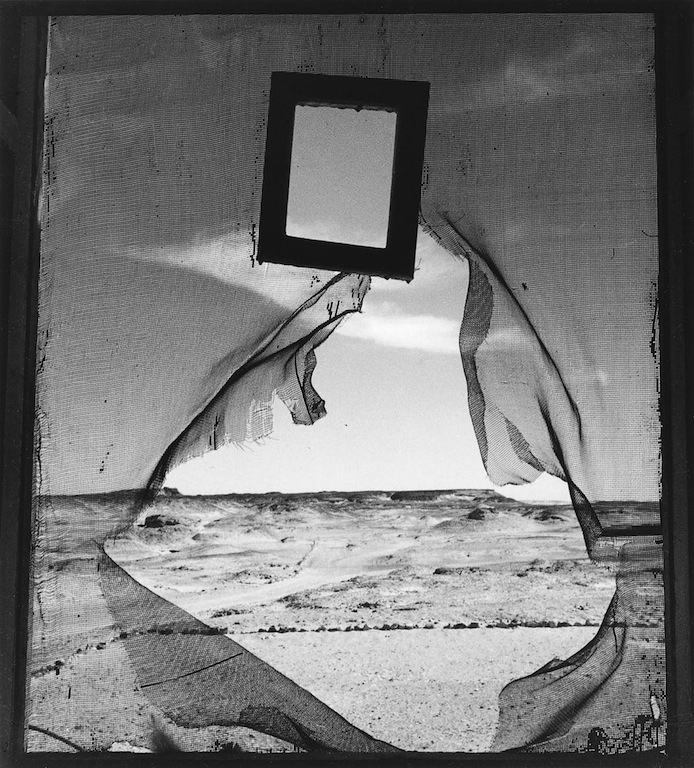
Portrait of Space by Lee Miller, 1937
In the mid-1930s, Lee Miller (1907-77) lived with her wealthy Egyptian husband in Cairo, and the American photographer escaped from the confinement she sometimes felt by making expeditions into the desert. Portrait of Space, taken on a trip to the Siwa oasis in 1937, is one of her most famous images, its title a collision of genres. The portrait is of a landscape, not a person, though the shape of the clouds recalls the lips of Miller floating in the sky in Man Ray’s painting The Lovers (1934), and two hillocks on the right can be seen—if we adopt the Surrealist perspective invited by the picture—as a pair of eyes. The gaping hole in the fly screen is also a kind of eye, opening on the scene.
So the “portrait” might encompass the entire vista framed by the window, or it might be the small patch of space, empty except for a wisp of cloud, enclosed by the picture frame attached so inexplicably to the netting. Miller is inside some kind of shelter, probably a hut. Outside, the land has been flattened, indicating long-term occupation, and the ground is distinguished from the desert by a boundary line made of stones: another form of framing. This imposition could suggest a colonial reading, if one knew this was Egypt, but the picture’s title is pointedly non-specific, and there is nothing within it to indicate the location. The Surrealists favored barren desertscapes as settings for their scenes of wonder, and Miller’s Portrait of Space, encountered in London, inspired Magritte to paint The Kiss (1938).
In The Art of Lee Miller, Mark Haworth-Booth publishes five versions of the scene. One of these, in the Getty collection, shows the entire window, though in this variant Miller has cropped away the wall seen in a version that was originally square. What becomes clear from comparisons is how much the electricity of the final image, sealed at the top in the darkroom by the printing frame, depends on its composition. Miller’s attempts to make a picture-within-a-picture of the distant bluff don’t quite come off—the small frame and the ruptured screen are uncomfortably low; there is too much air and a loss of tension. In the final version, the ragged aperture controls the space, absorbing large chunks of land and sky, and the point where the netting almost touches the bluff is perfectly calculated, causing sparks to fly between the two nodes, as Haworth-Booth suggests. In another delicate correspondence, the torn mesh lances through the torn cloud. Even if you know nothing about the photographer, the picture seems deeply psychological, an enigmatic melding of inner and outer worlds.See all Exposure columns


Comments [2]
11.19.15
03:37
11.23.15
01:50